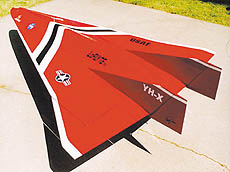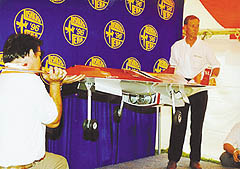|
|
|
 |
TECHNOLOGY
| |
AIRCRAFT THAT LEARNS
BY DOING
 Low-Observable Flight Test Experiment
(LoFLYTE)/Foto: www.astra.org.uk Low-Observable Flight Test Experiment
(LoFLYTE)/Foto: www.astra.org.uk
|
About five years ago National Aeronautics and Space
Administration (NASA) in cooperation with the United Stated Air
Force (USAF) unveiled a new kind of test aircraft that is able to
control itself while flying in the air. This jet-powered aircraft is
equipped with flight control technologies that demonstrate a
computerized flight control system that learns as it flies
especially important for the demands of ultra high-speed flight.
The test aircraft named Low-Observable Flight Test Experiment
(LoFLYTE) is designed to demonstrate the use of neural network
technique which is implemented into the aircraft control system to
learn by mimicking the pilot. The neural network is used on the
"worst-case scenario" situation that possibly happens when handling
the aircraft. The scenario means that the neural network can help
pilots of future aircraft to fly in quick-decision situation and
help damaged aircraft land safely even when aircraft controls such
as aileron, elevator or rudder is partially damaged.
Three main institutions, while not neglecting commercial sources,
were involved in this precious work. They are NASA Langley Research
Center (LaRC) of Hampton, Virginia led by James L. Hunt; Air Force
Wright Laboratory in Dayton, Ohio led by Dr. Kervyn Mach and
Accurate Automation Corp. of Chattanooga, Tennessee led by Bob Pap
that work under the Small Business Innovation Research (SBIR)
program. The test flight was done at Edwards Air Force Base,
California under the direction of the 445th Flight Test
Squadron with the support of NASA Dryden Flight Research Center. The
8-foot-4 inch jet-powered LoFLYTE Remotely-Piloted Vehicle (RPV) was
developed by Accurate Automation Corporation.
"Waverider" Aircraft
Besides designed to provide a technology test-bed for the
emerging aerospace technology emphasizing on the advantage of using
the neural network technology as the aircraft control system, the
LoFLYTE prototype was also designed to demonstrate the subsonic
airworthiness of the "waverider" shape aircraft. The term
"waverider" refers to the fact that aircraft of this type ride on
the shock waves that they create as they fly above the speed of
sound. The "waverider" shape improves fuel consumption by decreasing
air resistance at speeds greater than mach one. Other supersonic and
hypersonic aircraft suffer reduced performance because they fight
against the shock waves rather than riding them.
The initial configuration for the aircraft was developed at NASA
Langley Research Center and then Accurate Automation Corporation
integrated the neural network technology into it. The construction
of the aircraft was completed at SWB Turbines of Appleton,
Wisconsin. This company provided the small hypersonic air breathing
turbine engine that powers the aircraft. The aircraft's shell was
made at Mississippi State's Raspet Flight Research Laboratory and
then shipped to SWB Turbines so that the radio control gear and the
engine could be installed.
The "waverider" shape is based upon a high lift/drag Mach 5 and a
futuristic hypersonic aircraft configuration that could cruise on
top of its own shockwave if powered to hypersonic speeds. It takes
advantage of engine/body integration and was derived from a Mach 5
conical flowfield the cone-shaped shockwave generated by a
supersonic or hypersonic vehicle. This 72-pound "waverider"
aircraft, powered by a 38-pound air breathing hypersonic engine
built by SWB Turbines, would fly at speed above Mach 4. Mach 4 is
much faster than any aircraft with air breathing engines has ever
flown. The famous SR-71 Blackbird has a top speed that is
only slightly over Mach 3. LoFLYTE represents the first known flying
"waverider" air breathing vehicle configuration in the world.
The LoFLYTE first flight test was carried out on December 6, 1996
at Mojave Airport. After completing design, airworthiness and flight
safety reviews required by NASA and U.S. Air Force, it was flown
again at Edwards AFB, California and accomplished successfully.
Flight testing using neural network controls was begun in late 1997.
This flight test could not be successful without the help from NASA
Langley Research Center that did a wind tunnel test to the LoFLYTE
article as many as 191 runs in both the 12-foot Low Speed Tunnel and
30 x 60 foot wind tunnels. In addition, the Naval Postgraduate
School in Monterey, California also did water tunnel flow
visualization tests on a 72-inch long drop model. During the week of
June 23, 1997, LoFLYTE had made three successful flights at Edwards
AFB under the direction of the U.S. Air Force 445th
Flight Test Squadron.
Flight Control
 The LoFLYTE was designed to test the subsonic
airworthiness of the "waverider" shape aircraft refering to
the fact that it rides on the shock waves when flying above
the speed of sound/Foto: www.astra.org.uk The LoFLYTE was designed to test the subsonic
airworthiness of the "waverider" shape aircraft refering to
the fact that it rides on the shock waves when flying above
the speed of sound/Foto: www.astra.org.uk
|
The LoFLYTE Neural Network Flight Control System is an important
advance in aerospace technology because of the adaptive nature of
the control system. Neural network is a computer system that learns
by doing. The computer network consists of many interconnected
control systems or nodes, similar to neurons in the brain. Each node
assigns a value to the input from each of its counterparts then as
these values are changed, the network can adjust the way it
responds. Based on the neural network controller nature, the control
system, not the pilot, determines the most effective commands to the
aircraft for a particular situation.
The neural network control system, also designed and manufactured
by Accurate Automation Corporation, is based on the company's
successful Neural Network Processor (NNP®), also funded
under the SBIR program. The NNP® is a multiple
instruction/multiple data (MIMD) system that can be used in personal
computers as well as aircraft. With this advantage, the neural
network controller will be able to continually alter the aircraft's
control laws in order to optimize flight performance and take the
pilot's response into consideration. Over the time, the neural
network controller can be trained to control the aircraft. It will
learn to get the most optimized result from every situation it gets
can be said as learning from experience. So in the future, it
can apply the most precise control action when a certain situation
occurs during the flight.
During normal flight, the neural network controller will use the
data it receives from the telemetry system to compute the most
efficient flight characteristics and adjust the control surfaces
accordingly. However, the neural network control system has an
enormous advantage over traditional control systems during a
"worst-case scenario" situation such as abnormal or unexpected
flight conditions. For example, if the control system determines
that the rudder is not responding, it will adjust quickly to control
the aircraft using the remaining flight surfaces. Neural network
control system is necessary in hypersonic vehicles where the center
of gravity of the vehicle can change significantly throughout the
flight. The neural network can adjust to changing flight conditions
faster than a human pilot, greatly enhancing the safety of the
aircraft.
The speed of neural network controller's data processing becomes
much better because the communications inside LoFLYTE is done by
fiber optic "Fly-by-Light". The use of fiber optic offers lighter
weight, increased transmission capability and safety from electrical
short circuits and also Electromagnetic Interference (EMI). The
telemetry captures the data from the instrumentation in real-time
and displays it for operational decisions used to train the
neural network controller during the flight and transmission
to a remote site. The remote site is a Mobile Ground Control Station
(MGCS) that provides the flight test team with all of the facilities
needed to conduct flight testing, including all aircraft maintenance
and safety equipment, computers for telemetry and data recording,
and a weather station.
The Future
The NASA's LoFLYTE program has proven two things. First, it shows
that the "waverider" shape was successfully applied to an aircraft
model and the model could demonstrate what an aircraft normally does
from take-off, flying in the air and return to the land. There were
no difficulties for LoFLYTE to do those tasks. Second, application
of the neural network technology as "intelligent" aircraft control
system is feasible for this kind of aircraft configuration and the
neural network controller had shown its capability to control the
aircraft.
The longer version of LoFLYTE, 100-inch long, had also been
tested successfully at Edwards AFB. Following this success, the
larger transonic version was planned to be developed to explore
supersonic flight characteristics of the "waverider" shape. This
larger version will include a unique hypersonic flow path
configuration. An advanced engine controller was also developed for
ramjets under NASA Lewis Research Center SBIR program and would be
tested on the LoFLYTE aircraft.
Even though this aircraft model was designed for a Mach 5 conical
flowfield, the LoFLYTE, at that time, was not actually capable of
flying at hypersonic speeds. It has instead been tested for basic
handling characteristics at low-speeds such as take-off and landing.
But with this successful result, the team sees a big advantage to
using this type of control system in a hypersonic aircraft because
at that high speeds things happen so quickly that the pilot cannot
control the aircraft as easily as at subsonic speeds. Anyway, the
technologies that were successfully implemented in the LoFLYTE
program can eventually find their way into commercial, general
aviation and military aircraft.
The successful result of NASA's LoFLYTE program arises a question
such as "Do we still need pilots for future aircrafts
?" The answer will vary. It depends on how we view the
question. Back to the nature of the neural network that needs
"thing" to be mimicked means that the pilot is still needed. His
experience in handling an aircraft in every situation including
unexpected situations can be used as inputs to train the neural
network and as comparison to the neural network's output when
learning the inputs. How smart a neural network is cannot be
compared to the human brains. But, once it "graduates" from training
scheme and is ready to be used, its processing speed is much faster
than the human brains. So, there is a possibility to reduce new
pilots recruitment for the future aircraft. Who knows? (Air
Force Captain, Ir. Arwin "Daemon" Sumari, FSI, FSME, VDBM, SA
(Head of Simulator Operation, 3rd Fighter Wing
Training Facility, Iswahjudi AFB)
|










 Low-Observable Flight Test Experiment
(LoFLYTE)/Foto: www.astra.org.uk
Low-Observable Flight Test Experiment
(LoFLYTE)/Foto: www.astra.org.uk
 The LoFLYTE was designed to test the subsonic
airworthiness of the "waverider" shape aircraft refering to
the fact that it rides on the shock waves when flying above
the speed of sound/Foto: www.astra.org.uk
The LoFLYTE was designed to test the subsonic
airworthiness of the "waverider" shape aircraft refering to
the fact that it rides on the shock waves when flying above
the speed of sound/Foto: www.astra.org.uk